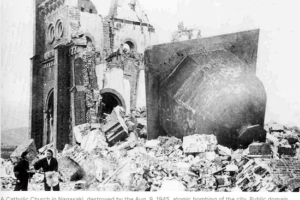CNA—August 9, 2023, marks the 78th anniversary of the second atomic bomb dropped by the United States on Japan, this time on Nagasaki, a city with a rich history of Christian martyrs from the 16th and 17th centuries.
On the day “Fat Man,” the name of the bomb, was dropped, the small Japanese Catholic community lost two-thirds of its members in the conflagration.
Nagasaki was not the original target
After the destruction of Hiroshima on Aug. 6, 1945, the U.S. military under commander-in-chief President Harry Truman set its sights on the city of Kokura to force the surrender of Japan.
However, bad weather caused the target to be changed to Nagasaki.
Nagasaki had about 240,000 inhabitants. A miscalculation by the Americans meant that the bomb did not fall on the center of the city, but the effect was still devastating and immediately killed some 75,000 people. In the days that followed, a similar number died from radiation injuries and illnesses.
History of the Catholic community in Nagasaki
Since the 16th century, Nagasaki has been an important center of Catholicism in Japan, initially evangelized by Jesuit and Franciscan missionaries.
The persecution against Catholics, which came almost immediately, was recalled in 2007 in the memoirs of Cardinal Giacomo Biffi, who died in 2017, in which he expressed the strong impact that the news of the atomic bombs dropped on Japan in 1945 had on him.
“I had already heard of Nagasaki,” he wrote. “I had come across it repeatedly in Giuseppe Schmidlin’s ‘Manual of the History of Catholic Missions,’ three volumes published in Milan in 1929. In Nagasaki, beginning in the 16th century, the first consistent Catholic community in Japan arose.”
“In Nagasaki,” he pointed out, “on Feb. 5, 1597, 36 martyrs had given their lives for Christ (six Franciscan missionaries, three Japanese Jesuits, and 26 laymen), canonized by Pius IX in 1862.”
Like embers from a flame, Forced into the catacombs, but faithful still — even without a priest
However, “when the persecution resumed in 1637, up to 35,000 Christians were killed. Then the young community lived, so to speak, in the catacombs, cut off from the rest of the Catholic community and without priests; but it was not extinguished.”
Discovered in 1865, so devout that they “tested” the discovering priest — only a true Catholic would do
Thus, in 1865 “Father [Bernard] Petitjean discovered this ‘clandestine Church,’ which was made known to him after they made sure that he was celibate, that he was devoted to Mary, and that he obeyed the pope of Rome, and thus the sacramental life could resume regularly,” Biffi continued.
Finally, religious freedom
Almost 20 years later, in 1889, “full religious freedom was proclaimed in Japan, and everything flourished.”
“On June 15, 1891, the Diocese of Nagasaki was canonically established, which in 1927 welcomed Bishop [Januarius] Hayasaka as pastor, who was the first Japanese bishop and was personally consecrated by Pius IX. … [I]n 1929, out of 94,096 Japanese Catholics, some 63,698 were from Nagasaki,” the cardinal noted.
That is to say, 16 years before the atomic hecatomb (an extensive loss of life), a little more than 63,000 faithful lived in Nagasaki.
Cardinal Giacomo Biffi wonders…
After this brief summary of Catholicism in this city, the cardinal wrote: “We can well assume that the atomic bombs were not dropped at random. The question is therefore unavoidable: How was this chosen for the second hecatomb, among all, precisely the city of Japan where Catholicism, apart from having the most glorious history, was most widespread and affirmed?”
RELATED RESOURCES:
Saints at Work: The Nagasaki mission house built by St. Maximilian Kolbe that survived the atomic bomb – Catholic Business Journal
History: U.S. Catholics fund replacement for cathedral bell destroyed in atomic bombing of Nagasaki – Catholic Business Journal
This Catholic Doctor lost everything in bombing of Nagasaki, EXCEPT Faith, Hope and Love – Catholic Business Journal
——–
article was first published by ACI Prensa, CNA’s Spanish-language news partner. It has been translated and adapted by CNA, reposted with permission.






You must be logged in to post a comment.